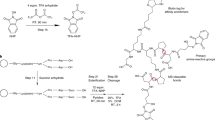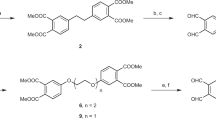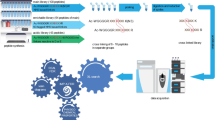Abstract
Chemical cross-linking, together with mass spectrometry (MS), is a powerful combination for probing subunit interactions within static protein assemblies. To probe conformational changes in response to stimuli, we have developed a comparative cross-linking strategy, using lysine-specific deuterated and nondeuterated bis(sulfosuccinimidyl)suberate cross-linking reagents (BS3). Here we describe the experimental procedures as well as the data analysis, validation and interpretation. The protocol involves first assigning cross-linked peptides in the complex without ligand binding, or with post-translational modifications (PTMs) at natural abundance, using a standard procedure with labeled cross-linkers, proteolysis and assignment of cross-linked peptides after liquid chromatography–tandem MS (LC-MS/MS) and database searching. An aliquot of the protein complex is then exposed to a stimulus: either ligand binding or incubation with a phosphatase or kinase to bring about changes in PTMs. Two solutions—one containing the apo/untreated complex and the other containing the enzymatically modified/ligand-bound complex—are then cross-linked independently. Typically, nondeuterated BS3-d0 is used for the untreated complex and deuterated BS3-d4 is used for the experiment. The two aliquots are then incubated at equal concentrations, digested and processed as before. The ratios of labeled and unlabeled cross-linked peptides provide a direct readout of the effect of the stimulus. We exemplify our method by quantifying changes in subunit interactions induced by dephosphorylation of an ATP synthase. The protocol can also be used to determine the conformational changes in protein complexes induced by various stimuli including ligand/drug binding, oligomerization and other PTMs. Application of the established protocol takes ∼9 d, including protein complex purification.
This is a preview of subscription content, access via your institution
Access options
Subscribe to this journal
Receive 12 print issues and online access
$259.00 per year
only $21.58 per issue
Buy this article
- Purchase on Springer Link
- Instant access to full article PDF
Prices may be subject to local taxes which are calculated during checkout







Similar content being viewed by others
References
Herzog, F. et al. Structural probing of a protein phosphatase 2A network by chemical cross-linking and mass spectrometry. Science 337, 1348–1352 (2012).
Leitner, A. et al. The molecular architecture of the eukaryotic chaperonin TRiC/CCT. Structure 20, 814–825 (2012).
Chen, Z.A. et al. Architecture of the RNA polymerase II-TFIIF complex revealed by cross-linking and mass spectrometry. EMBO J. 29, 717–726 (2010).
Rouillon, C. et al. Structure of the CRISPR interference complex CSM reveals key similarities with cascade. Mol. Cell. 52, 124–134 (2013).
Politis, A. et al. A mass spectrometry-based hybrid method for structural modeling of protein complexes. Nat. Methods 11, 403–406 (2014).
Rappsilber, J. The beginning of a beautiful friendship: cross-linking/mass spectrometry and modelling of proteins and multi-protein complexes. J. Struct. Biol. 173, 530–540 (2011).
Sinz, A. Chemical cross-linking and mass spectrometry to map three-dimensional protein structures and protein-protein interactions. Mass Spectrom. Rev. 25, 663–682 (2006).
Aebersold, R. & Mann, M. Mass spectrometry-based proteomics. Nature 422, 198–207 (2003).
Pearson, K.M., Pannell, L.K. & Fales, H.M. Intramolecular cross-linking experiments on cytochrome c and ribonuclease A using an isotope multiplet method. Rapid Commun. Mass Spectrom. 16, 149–159 (2002).
Leitner, A. et al. Probing native protein structures by chemical cross-linking, mass spectrometry, and bioinformatics. Mol. Cell. Proteomics 9, 1634–1649 (2010).
Wlodawer, A., Minor, W., Dauter, Z. & Jaskolski, M. Protein crystallography for aspiring crystallographers or how to avoid pitfalls and traps in macromolecular structure determination. FEBS J. 280, 5705–5736 (2013).
Bai, X.C., Fernandez, I.S., McMullan, G. & Scheres, S.H. Ribosome structures to near-atomic resolution from thirty thousand cryo-EM particles. Elife 2, e00461 (2013).
Mainz, A. et al. NMR spectroscopy of soluble protein complexes at one mega-dalton and beyond. Angew Chem. Int. Ed. Engl. 52, 8746–8751 (2013).
Hyung, S.J. & Ruotolo, B.T. Integrating mass spectrometry of intact protein complexes into structural proteomics. Proteomics 12, 1547–1564 (2012).
Zhong, Y., Hyung, S.J. & Ruotolo, B.T. Ion mobility-mass spectrometry for structural proteomics. Expert Rev. Proteomics 9, 47–58 (2012).
Wales, T.E. & Engen, J.R. Hydrogen exchange mass spectrometry for the analysis of protein dynamics. Mass Spectrom. Rev. 25, 158–170 (2006).
Schwarz, R. et al. Monitoring conformational changes in peroxisome proliferator-activated receptor α by a genetically encoded photoamino acid, cross-linking, and mass spectrometry. J. Med. Chem. 56, 4252–4263 (2013).
Serpa, J.J. et al. Using multiple structural proteomics approaches for the characterization of prion proteins. J. Proteomics 81, 31–42 (2013).
Marcoux, J. et al. Mass spectrometry reveals synergistic effects of nucleotides, lipids, and drugs binding to a multidrug resistance efflux pump. Proc. Natl. Acad. Sci. USA 110, 9704–9709 (2013).
Politis, A., Park, A.Y., Hall, Z., Ruotolo, B.T. & Robinson, C.V. Integrative modelling coupled with ion mobility mass spectrometry reveals structural features of the clamp loader in complex with single-stranded DNA binding protein. J. Mol. Biol. 425, 4790–4801 (2013).
van Duijn, E. et al. Native tandem and ion mobility mass spectrometry highlight structural and modular similarities in clustered-regularly-interspaced shot-palindromic-repeats (CRISPR)-associated protein complexes from Escherichia coli and Pseudomonas aeruginosa. Mol. Cell. Proteomics 11, 1430–1441 (2012).
Xu, G. & Chance, M.R. Hydroxyl radical-mediated modification of proteins as probes for structural proteomics. Chem. Rev. 107, 3514–3543 (2007).
Schmidt, C. et al. Comparative cross-linking and mass spectrometry of an intact F-type ATPase suggest a role for phosphorylation. Nat. Commun. 4, 1985 (2013).
Ong, S.E. et al. Stable isotope labeling by amino acids in cell culture, SILAC, as a simple and accurate approach to expression proteomics. Mol. Cell. Proteomics 1, 376–386 (2002).
Bantscheff, M., Schirle, M., Sweetman, G., Rick, J. & Kuster, B. Quantitative mass spectrometry in proteomics: a critical review. Anal. Bioanal. Chem. 389, 1017–1031 (2007).
Preston, G.W., Radford, S.E., Ashcroft, A.E. & Wilson, A.J. Analysis of amyloid nanostructures using photo-cross-linking: in situ comparison of three widely used photo-cross-linkers. ACS Chem. Biol. 9, 761–768 (2014).
Gotze, M. et al. StavroX: a software for analyzing crosslinked products in protein interaction studies. J. Am Soc. Mass Spectrom. 23, 76–87 (2012).
Walzthoeni, T. et al. False discovery rate estimation for cross-linked peptides identified by mass spectrometry. Nat. Methods 9, 901–903 (2012).
Xu, H., Hsu, P.H., Zhang, L., Tsai, M.D. & Freitas, M.A. Database search algorithm for identification of intact cross-links in proteins and peptides using tandem mass spectrometry. J. Proteome Res. 9, 3384–3393 (2010).
Rinner, O. et al. Identification of cross-linked peptides from large sequence databases. Nat. Methods 5, 315–318 (2008).
Fischer, L., Chen, Z.A. & Rappsilber, J. Quantitative cross-linking/mass spectrometry using isotope-labelled cross-linkers. J. Proteomics 88, 120–128 (2013).
Petrotchenko, E.V. & Borchers, C.H. Crosslinking combined with mass spectrometry for structural proteomics. Mass Spectrom. Rev. 29, 862–876 (2010).
Shevchenko, A., Wilm, M., Vorm, O. & Mann, M. Mass spectrometric sequencing of proteins silver-stained polyacrylamide gels. Anal. Chem. 68, 850–858 (1996).
Acknowledgements
We acknowledge funding from the Wellcome Trust (WT008150 and WT099141) and the European Research Council (ERC) IMPRESS grant (ERC 268851) to C.V.R. C.V.R. is a Royal Society Professor.
Author information
Authors and Affiliations
Contributions
C.S. and C.V.R. designed the research; C.S. performed the experiments and analyzed the data; and C.S. and C.V.R. wrote the manuscript.
Corresponding author
Ethics declarations
Competing interests
The authors declare no competing financial interests.
Rights and permissions
About this article
Cite this article
Schmidt, C., Robinson, C. A comparative cross-linking strategy to probe conformational changes in protein complexes. Nat Protoc 9, 2224–2236 (2014). https://doi.org/10.1038/nprot.2014.144
Published:
Issue Date:
DOI: https://doi.org/10.1038/nprot.2014.144
This article is cited by
-
Promiscuity of response regulators for thioredoxin steers bacterial virulence
Nature Communications (2022)
-
Structural insight into the formation of lipoprotein-β-barrel complexes
Nature Chemical Biology (2020)
-
Proper evaluation of chemical cross-linking-based spatial restraints improves the precision of modeling homo-oligomeric protein complexes
BMC Bioinformatics (2019)
-
Yeast R2TP Interacts with Extended Termini of Client Protein Nop58p
Scientific Reports (2019)
-
KRAS regulation by small non-coding RNAs and SNARE proteins
Nature Communications (2019)
Comments
By submitting a comment you agree to abide by our Terms and Community Guidelines. If you find something abusive or that does not comply with our terms or guidelines please flag it as inappropriate.



